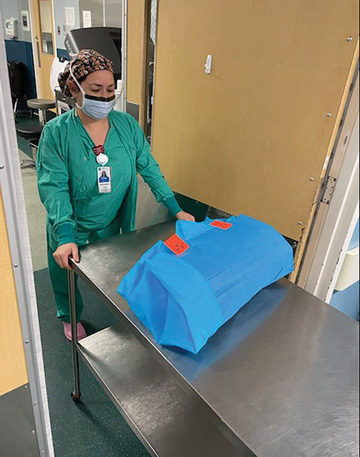Rigid sterilization containers are not only easier to store than blue-wrapped trays, but also reduce unnecessary reprocessing resulting from accidental tears.
 Ron Hester Photography
Ron Hester Photography STRONG VALUE Richard Ortiz, CRCST, senior director of central sterile processing and durable medical equipment at Hospital for Special Surgery, says rigid containers have provided multiple benefits for the facility.
The sterile processing department (SPD) is the heartbeat of any healthcare facility, and its ability to safely handle and sanitize instruments is key to keeping patients safe from SSIs. Richard Ortiz, CRCST, senior director of central sterile processing and durable medical equipment at Hospital for Special Surgery in New York City, says his facility’s heavily reliance on rigid sterilization containers to keep instruments secure and sterile reflects that ongoing mission.
“When used correctly,” he says, “rigid sterilization containers benefit our department in important ways,” he says. Those benefits include:
Maximizing storage space. Rigid containers are constructed from stainless steel or anodized aluminum, which are sturdy materials that won’t easily bend or crack. That makes them inherently stackable. “Unlike instrument trays wrapped in blue wrap, you can stack containers in storage two at a time, one on top of the other, as long as they are the same size,” says Mr. Ortiz.
Providing barrier protection. “Holes in blue wrap are often caused by sharp corners or when a staff member mishandles a tray,” says Mr. Ortiz. Instruments can punch through blue wrap when sterilized trays are stacked, or when a reprocessing technician tosses a sterilized tray onto a case cart rather than carefully placing it there. “Heavy and often bulky orthopedic tools can strain and stretch blue wrap,” adds Mr. Ortiz. “Once the blue wrap is punctured, our department is forced to reprocess the tray, which can cause unwanted case delays, something a busy surgical facility cannot afford,” he says, adding that rigid containers largely eliminate this problem.
While rigid containers provide these benefits and more, Mr. Ortiz also stresses that, like the instruments they contain, they must be properly maintained. He advises facility leaders to factor regular maintenance requirements and the expense of replacement parts into their evaluations and implementations of these products.
“Some containers require four filters that provide a microbial barrier while others only require two,” he says by way of example. “The gasket under the lid of many containers that creates a seal can tear after repeated use, and a container’s locking mechanisms might need to be tightened or replaced from time to time.”
While advocating strongly for the usage of rigid containers, Mr. Ortiz recommends doing your research before you place a large order with a manufacturer to make sure you get a durable and reliable product.
.svg?sfvrsn=be606e78_3)


.svg?sfvrsn=56b2f850_5)